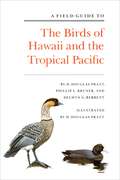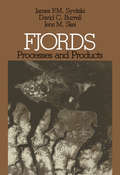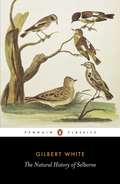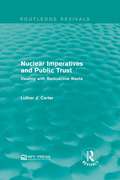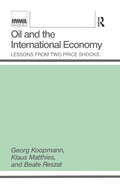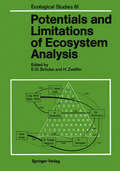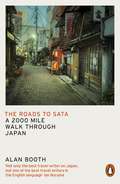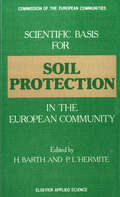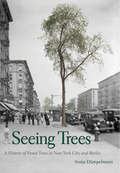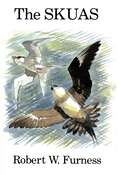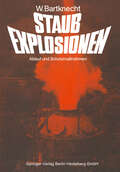- Table View
- List View
A Field Guide to the Birds of Hawaii and the Tropical Pacific
by H. Douglas Pratt Phillip L. Bruner Delwyn G. BerrettThis is the first field guide to the identification of the birds of the islands of the tropical Pacific, including the Hawaiian Islands, Fiji, Samoa, Tonga, southeastern Polynesia, and Micronesia. It is intended both as a reference for the expert and as an introduction to birding in the region for the novice. Small enough to be carried afield, it contains much previously unpublished information about behavior, vocalizations, ecology, and distribution. The forty-five color plates depict all plumages of all bird species that breed in the islands, as well as of those that regularly visit them and the surrounding oceans, and of most species believed to be extinct on the islands. Black-and-white figures show many of the rarer visitors.Introductory sections discuss the tropical Pacific as an environment for birds, problems of birding on islands, and bird conservation. Appendixes include maps of the island groups and a thorough bibliography.
Fjords: Processes and Products
by James P.M. Syvitski David C. Burrell Jens M. SkeiFjords are both an interface and a buffer between glaciated continents and the oceans. They exhibit a very wide range in environmental conditions, both in dynamics and geography. Some are truly wonders of the world with their dizzying mountain slopes rising sharply from the ocean edge. Others represent some of the harshest conditions on earth, with hurricane winds, extremes in temperature, and catastrophic earth and ice movements. Fjords are unique estuaries and represent a large portion of the earth's coastal zone. Yet they are not very well known, given the increasing population and food pressures, and their present industrial and strategic importance. Temperate zone estuaries have had many more years of intense study, with multiyear data available. Most fjords have not been impacted by man but, if history repeats itself, that condition will not last long. Fjords present some unique environmental problems, such as their usually slow flushing time, a feature common to many silled environments. Thus there is presently a need for management guidelines, which can only be based on a thorough knowledge of the way fjords work. Fjords are, in many respects, perfect natural oceanographic and geologic lab oratories. Source inputs are easily identified and their resulting gradients are well developed. Throughout this book, we emphasize the potential of modeling pro cesses in fjords, with comparisons to other estuary, lake, shelf and slope, and open ocean environments.
Genetic Aspects of Plant Mineral Nutrition: Proceedings of the Second International Symposium on Genetic Aspects of Plant Mineral Nutrition, organized by the University of Wisconsin, Madison, June 16–20, 1985 (Developments in Plant and Soil Sciences #27)
by W. H. Gabelman B. C. LoughmanThis volume presents the proceedings of the Second International Sym posium on Genetic Aspects ofPlant Minerai Nutrition, held in Madison, Wisconsin in 1985. The mechanisms by which plants acquire, transport and utilize essential minerai nutrients are highly complex. The means by which plants either exclude or tolerate ions of metals toxic to plants are equally complex. The first symposium attempted to convene research scientists con cerned with minerai nutrition for the purpose of exploring the kinds of minerai nutrition phenomena identified as being under genetic contro!. The first symposium also placed much emphasis on research to which genetic intervention might be applied. At the second symposium more papers were presented on genetic and breeding research, a long-term objective of the first symposium. The second symposium also included biotic interactions under genetic con trol that either enhanced or impeded ion uptake, e.g. mycorrhizae and nitrogen fixing bacteria. This continuing dialogue is essential for a research area the complexity of which is due to its interdisciplinary nature.
Genetic Engineering: Principles and Methods Volume 9 (Genetic Engineering: Principles and Methods #8)
by Jane SetlowHormonal Control of Tree Growth: Proceedings of the Physiology Working Group Technical Session, Society of American Foresters National Convention, Birmingham, Alabama, USA, October 6–9, 1986 (Forestry Sciences #28)
by S. V. Kossuth Steve D. RossThis is the third annual compendium of a Technical Session of the Physiology Working Group of the Society of American Foresters held at the National Convention. Specialists in a dedicated area of tree physiology were invited to prepare chapter contributions synthesizing the status of knowledge in their area of expertise. Plant growth regulators (PGRs) was selected as the topic for in-depth examination at the 1986 Technical Session because a knowledge of how these "secondary messengers" regulate tree morphogenesis is vital to applications of biocontrol and biotechnology. Plant growth regulators have been the subject of numerous reviews in recent years. However, few have dealt specifically with woody perennials, and they are generally confined to single processes and/or organs. This volume attempts to provide a more comprehensive treatise of PGRs as they influence various ontogenetic events in forest trees. Reproductive physiology, both sexual and asexual, is emphasized because of its relevance to current efforts directed at increasing efficiency in the breeding and production of genetically improved trees for reforestation. The chapters on vegetative growth will be of interest to silviculturists and urban foresters as they consider cultural treatments in the management of forests and individual trees for specific products and purposes. This book should serve as a valuable text and source of reference for students, researchers and other professionals interested in gaining a better understanding of PGRs. The reader, however, who expects definitive answers to how PGRs function or can be used to control specific processes is likely to be disappointed.
Insulin, Insulin-like Growth Factors, and Their Receptors in the Central Nervous System
by Mohan RaizadaTraditionally, intercellular communication and the regulation of biological functions of the body have been considered the role of two major and distinct systems: the nervous system and the endocrine system. The classic nervous system transmitted its signal rapidly by using electrical currents, whereas the signals used by the endocrine system were hormones produced by endocrine glands which reached the target tissues via the blood stream. During the past few decades, it has become apparent that these systems of intercellular com munication are not distinct and the signal messenger molecules are not unique to one or the other system. Many classic endocrine hormones are found in and act on nervous tissues and evidence exists for their de novo synthesis by neural related tissues. An exciting development in this area is the possibility that insulin and insulin-like growth factors (IGF) are not only produced by neural tissues but also exert profound physiological and biochemical effects on these tissues. The area of investigation of CNS insulin and IGF has been expanding rapidly and the availability of this book complete with up-to-date reviews on the subject by leaders in the field allows other scientists to utilize the knowledge in planning and adapting the latest ideas for future experiments. In addition, the book provides a collection of up-to-date articles for teachers to be used for the latest instructional material. The first section of the book covers general aspects of insulin receptors and insulin action.
Metallic Mineral Exploration: An Economic Analysis (Routledge Revivals)
by Roderick G. EggertHow has exploration for minerals evolved in recent years? Is it as productive an activity as it once was? Why have changes occurred? Roderick G. Eggert explores these and other questions about the complex set of circumstances surrounding metallic mineral exploration. Originally published in 1987, Eggert documents trends in the level and the distribution of expenditures by mining companies for metallic mineral exploration and examines a number of factors that may be responsible for these trends. This significant study serves as a handy introduction to the subject for students interested in environmental studies, natural resources, and economics.
Metallic Mineral Exploration: An Economic Analysis (Routledge Revivals)
by Roderick G. EggertHow has exploration for minerals evolved in recent years? Is it as productive an activity as it once was? Why have changes occurred? Roderick G. Eggert explores these and other questions about the complex set of circumstances surrounding metallic mineral exploration. Originally published in 1987, Eggert documents trends in the level and the distribution of expenditures by mining companies for metallic mineral exploration and examines a number of factors that may be responsible for these trends. This significant study serves as a handy introduction to the subject for students interested in environmental studies, natural resources, and economics.
The Mining Law: A Study in Perpetual Motion (Routledge Revivals)
by John D. LeshyOriginally published in 1987, John D. Leshy presents this scholarly study of the 1872 Mining Law as a legal treatise and history of mining in the West from the point of view of mineral exploration and production. This mining law governed the United States mining practice yet had never been changed. The Mining Law attempts to highlight the role of policy and government as well as the more obscure elements of the law which complicated mining practice in the eighties. This title will be of interest to students of Environmental Studies and policy makers.
The Mining Law: A Study in Perpetual Motion (Routledge Revivals)
by John D. LeshyOriginally published in 1987, John D. Leshy presents this scholarly study of the 1872 Mining Law as a legal treatise and history of mining in the West from the point of view of mineral exploration and production. This mining law governed the United States mining practice yet had never been changed. The Mining Law attempts to highlight the role of policy and government as well as the more obscure elements of the law which complicated mining practice in the eighties. This title will be of interest to students of Environmental Studies and policy makers.
The Natural History of Selborne: Observations On Various Parts Of Nature
by Gilbert White Richard MabeyMore than any other writer Gilbert White (1720-93) has shaped the relationship between man and nature. A hundred years before Darwin, White realised the crucial role of worms in the formation of soil and understood the significance of territory and song in birds. His precise, scrupulously honest and unaffectedly witty observations led him to interpret animals' behaviour in a unique manner. This collection of his letters to the explorer and naturalist Daines Barrington and the eminent zoologist Thomas Pennant - White's intellectual lifelines from his country-village home - are a beautifully written, detailed evocation of the lives of the flora and fauna of eighteenth-century England.
Nuclear Imperatives and Public Trust: Dealing with Radioactive Waste (Routledge Revivals)
by Luther J. CarterThis title, first published in 1987, examines the topic of nuclear waste management, and the way in which the public reacts to this issue. Part 1 explores the sources of public unease, such as the way in which nuclear waste had failed to be properly contained in the past. Part 2 looks at the search for a waste policy and the introduction of The Nuclear Waste Policy Act. Part 3 examines the waste problem from the standpoint of it being an international issue, and finally, Part 4 looks to the future and the lessons that we can learn from past nuclear waste management failures. This book will be of interest to students of environmental management.
Nuclear Imperatives and Public Trust: Dealing with Radioactive Waste (Routledge Revivals)
by Luther J. CarterThis title, first published in 1987, examines the topic of nuclear waste management, and the way in which the public reacts to this issue. Part 1 explores the sources of public unease, such as the way in which nuclear waste had failed to be properly contained in the past. Part 2 looks at the search for a waste policy and the introduction of The Nuclear Waste Policy Act. Part 3 examines the waste problem from the standpoint of it being an international issue, and finally, Part 4 looks to the future and the lessons that we can learn from past nuclear waste management failures. This book will be of interest to students of environmental management.
Oil and the International Economy
by Georg Koopmann Klaus Matthies Beate ReszatThe oil price increases of the 1970s left deep marks on the world economy. They led to a massive redistribution of income in favor of oil-producing countries, and caused serious disruption of growth, imbalances in foreign trade, and problems of stability in oil-importing countries. Despite the present levelling off, the authors suggest that more price increases remain a distinct possibility.Oil and the International Economy examines the effects of rising oil prices on the international financial system and identifies ways that oil-importing countries can overcome the financial and adjustment problems caused by them. The authors project the long-term trend in real oil prices and present economic policy options to help avoid future financial problems for industrialized and developing nations alike.
Oil and the International Economy
by Georg Koopmann Klaus Matthies Beate ReszatThe oil price increases of the 1970s left deep marks on the world economy. They led to a massive redistribution of income in favor of oil-producing countries, and caused serious disruption of growth, imbalances in foreign trade, and problems of stability in oil-importing countries. Despite the present levelling off, the authors suggest that more price increases remain a distinct possibility.Oil and the International Economy examines the effects of rising oil prices on the international financial system and identifies ways that oil-importing countries can overcome the financial and adjustment problems caused by them. The authors project the long-term trend in real oil prices and present economic policy options to help avoid future financial problems for industrialized and developing nations alike.
Plant and Soil Interfaces and Interactions: Proceedings of the International Symposium: Plant and Soil: Interfaces and Interactions. Wageningen, The Netherlands August 6–8, 1986 (Developments in Plant and Soil Sciences #28)
by S. Dasberg A. Houwers S.K. de Datta R.O.D. Dixon M.A. El-Sharkawy R. Rodriguez-KábanaForty years ago, when PLANT AND SOIL first appeared, Europe was still recovering from the devastating effects of World War II. During the war years, work in many centres of agricultural research had come to a virtual standstill. Buildings and equipment were destroyed, scientists were often forced to terminate their research and teaching activities and funds allocated to such work were diverted to other, at that time, more pressing needs. During the first post-war years reconstruction was undertaken with great zeal and in that light the founding of the new journal PLANT AND SOIL must be viewed. In the pre-war period most agricultural science journals were still primarily national ones and consequently many articles were published in languages mastered by only a limited number of potential readers. In small countries whose languages are not widely understood, the desire arose to publish research findings in one of the major languages. It is therefore understandable that in the early years of the journal's existence, large portions of PLANT AND SOIL were filled with articles from the Scandinavian countries and The Nether lands. Originally, rather frequent use was made of the opportunity to publish also in German and French, but with the advance of English as a major language of communication, a decline was noticeable in the number of German and French manuscripts submitted. As a consequence the Edi torial Board has recently decided to terminate the publishing of articles in these languages.
Polychlorinated Biphenyls (Environmental Toxin Series #1)
by R. L. Dedrick L. G. Hansen M. A. Hayes R. J. Lutz M. Mullin A. Parkinson L. Safe S. Safe R. G. Schnellmann I. G. SipesPolychlorinated biphenyls (PCBs) have been produced commercially since be fore 1930. They proved to be highly versatile mixtures and their uses continued to expand during the early 1970's even after the unanticipated world-wide en vironmental contamination had been discovered (Jensen et aI. , 1969; Koeman et aI. , 1969). Over 600,000 metric-tons were produced and/or used in the U. S. during this time and it is estimated that worldwide production totaled about 1,200,000 metric-tons (Table 1). With low acute toxicities (Fishbein, 1974), these mixtures were considered gen erally biologically inactive even though industrial exposure had demonstrated he patic and dermatological effects (Fishbein, 1974; Hansen, 1987). Thus, use and disposal were not carefully monitored and it is estimated that one-third of the world-wide production of PCBs has been released into the global environment (Table 1). Table 1. Estimated production and disposition of PCBs b U. s. a Worldwide 6 6 Production/use 610 X 10 kg 1200 X 10 kg Mobil environmental reservoir 82 400 Static reservoirs In service 340 Dumps 130 Total static 470 800 a NAS, 1979 b Tatsukawa and Tanaba, 1984 2 Environmental Distribution Many countries now impose strict controls on the use and release of PCBs. Re lease into the environment has declined dramatically in the last decade, but con tinued release from reservoirs (Table 1) into burdened ecosystems (Table 2) ap pears inevitable for several more decades (Barros et aI. , 1984).
Potentials and Limitations of Ecosystem Analysis (Ecological Studies #61)
by Ernst-Detlef Schulze Helmut ZwölferThe identification of inputs and outputs is the first and probably most important step in testing and analyzing complex systems. Following accepted natural laws such as the conservation of mass and the principle of electroneutrality, the input/output analysis of the system, be it steady or in connection with perturbations will reveal the status dynamic, will identify whether changes are reversible or irreversible and whether changing the input will cause a hysteresis response. Moreover, measurements ofinput and output fluxes can indicate the storage capacity ofa system, its resilience to buffer or amplify variations of the external input, and it can identify structural changes. Therefore, to a certain extent, the input/output analysis can facilitate predictions about the ecosystem stability. The measurement of fluxes and the determination of inputs and outputs of eco systems are, in many aspects, analogous to measurements done by engineers when testing an electronic apparatus. The first step is the measurement ofthe input/output properties of the instrument as a whole, or ofvarious circuit boards, and the compari· son ofthese with the expected variations of the original design. Varying input and out· put can give valuable information about the stability and the regulatory properties of the device. Nevertheless, only the circuit as an entity has specific properties which cannot be anticipated if the individual components are investigated regardless oftheir position. Also, the instrument as a whole will have different input/output properties than its subcircuits.
The Roads to Sata: A 2000-mile walk through Japan
by Alan Booth'A memorable, oddly beautiful book' Wall Street Journal'A marvellous glimpse of the Japan that rarely peeks through the country's public image' Washington PostOne sunny spring morning in the 1970s, an unlikely Englishman set out on a pilgrimage that would take him across the entire length of Japan. Travelling only along small back roads, Alan Booth travelled on foot from Soya, the country's northernmost tip, to Sata in the extreme south, traversing three islands and some 2,000 miles of rural Japan. His mission: 'to come to grips with the business of living here,' after having spent most of his adult life in Tokyo.The Roads to Sata is a wry, witty, inimitable account of that prodigious trek, vividly revealing the reality of life in off-the-tourist-track Japan. Journeying alongside Booth, we encounter the wide variety of people who inhabit the Japanese countryside - from fishermen and soldiers, to bar hostesses and school teachers, to hermits, drunks and the homeless. We glimpse vast stretches of coastline and rambling townscapes, mountains and motorways; watch baseball games and sunrises; sample trout and Kilamanjaro beer, hear folklore, poems and smutty jokes. Throughout, we enjoy the wit and insight of a uniquely perceptive guide, and more importantly, discover a new face of an often-misunderstood nation.
A Sand County Almanac: And Sketches Here and There
by Aldo Leopold'One of the most influential books about the natural world ever published' Paul Kingsnorth, Guardian'There are some who can live without wild things, and some who cannot,' begins Aldo Leopold's totemic work of ecological thought. Ranging from lyrical observations of the changing seasons over a year on his Wisconsin farm to his hugely influential idea of a 'land ethic' signifying moral equilibrium between humans and all other life on earth, A Sand County Almanac changed perceptions of the natural world and helped give birth to the modern conservation movement.'An unequivocal statement of conscience that will carry down the generations ... his argument seems more urgently true now than ever' The New York Times
Scientific Basis for Soil Protection in the European Community
by H. Barth P. L'HermitePH. BOURDEAU Directorate-General Science. Research and Development. Commission of the European Communities. Brussels. Belgium We are living on a unique planet, the only one in the solar system where life exists. The very existence of life has modified the physical and chemical environment of the earth, its atmosphere and oceans, in a way that makes life sustainable. This system with its complex cybernetic mechanisms has been named GAIA by Lovelock. Man has always interfered with it on a more or less limited scale. This interference is now reaching global proportions such as climate modifications resulting from CO and trace gas 2 accumulation in the atmosphere or the destruction of stratospheric ozone, not to speak of global radioactive contamination. GAIA will probably prevail as a living system but it probably does not give much importance to man's survival as such, and it is man that has to take care of his own survival. In the ecosystem of Planet Earth, soils are the thin interface between lithosphere and atmosphere which constitutes the essential substrate for the terrestrial biosphere, the productivity of which far exceeds that of the oceans, even though the latter cover a much larger area than the continents. Soils themselves are complex systems. They develop through weathering of minerals, are colonised by living organisms which in turn modify their substrate making it suitable for other organisms. This induces a primary ecological succession which eventually reaches a climax, in equilibrium between climate, soil and the biological communities.
Seeing Trees: A History of Street Trees in New York City and Berlin (Seeing Ser.)
by Sonja DümpelmannA fascinating and beautifully illustrated volume that explains what street trees tell us about humanity’s changing relationship with nature and the city Today, cities around the globe are planting street trees to mitigate the effects of climate change. However, as landscape historian Sonja Dümpelmann explains, the planting of street trees in cities to serve specific functions is not a new phenomenon. In her eye-opening work, Dümpelmann shows how New York City and Berlin began systematically planting trees to improve the urban climate during the nineteenth century, presenting the history of the practice within its larger social, cultural, and political contexts. A unique integration of empirical research and theory, Dümpelmann’s richly illustrated work uncovers this important untold story. Street trees—variously regarded as sanitizers, nuisances, upholders of virtue, economic engines, and more—reflect the changing relationship between humans and nonhuman nature in urban environments. Offering valuable insights and frameworks, this authoritative volume will be an important resource for years to come.
The Skuas (Poyser Monographs #64)
by Robert W. FurnessMany birdwatchers may never have seen a skua; those who have will most probably have vivid memories of one or other species flying powerfully past a headland, or twisting and diving in pursuit of its piratical intentions towards a food-laden seabird - or, perhaps more memorably still, of themselves taking evasive action from the power-diving irate skua whose territory they have unwisely invaded. The full classification of the skuas is still debated, but Dr Furness of the Applied Ornithology Unit, Glasgow University, favours six species, of two genera, with five subspecies, based on current knowledge and his own long and dedicated field studies and research. All of the species are treated comparatively under the following chapter titles: Early history and classification, Distributions and populations, Migration patterns, Reversed sexual size dimorphism, Behaviour, Food and feeding, Kleptoparasitism, Plumage polymorphism, Breeding systems and social organisation, Breeding - laying to hatching, Breeding - hatching to fledging, Population dynamics, Pollutants, Skuas and agriculture, Skuas and conservation. The text is supported by 100 maps and diagrams, 30 photographs and 65 tables. In addition, John Busby contributes 35 evocative drawings which more than embellish this erudite and readable summary of an impressive and diverse group of birds. Jacket paintings by John Busby
